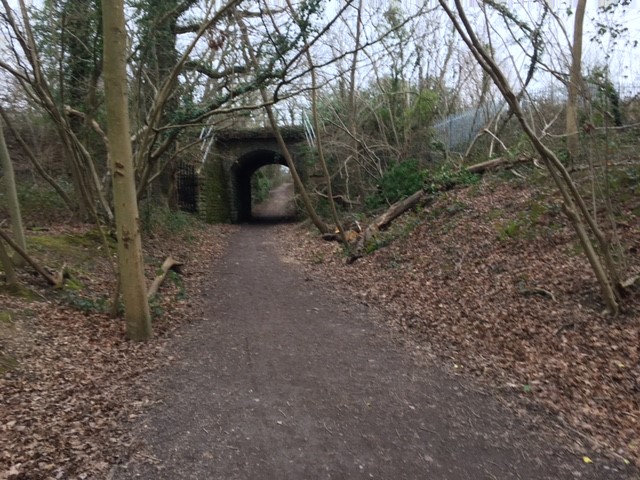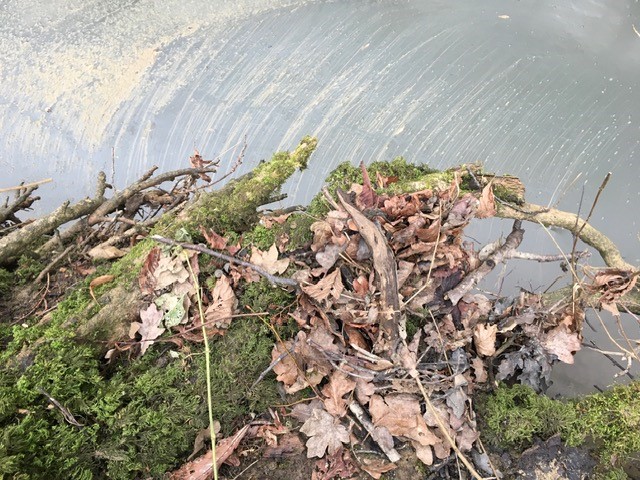Walking in a spiral, it took me a while to get my bearings at Christ’s Hospital station. As it turned out, this was the best route to get to the woodland to the north, following the Downslink as it skirted the station.
I picked up a few tarmac mosses, then grass verge species including Fissidens incurvus and hopped over a stile to inspect a contorted tree with more moss variety than is usual on Oak. Syntrichia laevipila and Pulvigera lyellii fringed the top of low boughs.

A small bridge carried the railway over the path, the soft stone patchworked with mosses. Pale Neckera complanata flicked out from the base of the wall and a dense, forest green moss covered some stones in velvet upholstery but others were left bare, probably depending on the porosity of the stones. Under the microscope I noticed jagged teeth at the base of the leaves, a characteristic only seen on the tufa-forming Eucladium verticillatum amongst British mosses.

There are just three West Sussex records for Eucladium and only one recent one from cellars at Uppark, found by Tom in 2014, but no previous records at all for this north-east corner of the vice-county. It is more common in East Sussex, particularly in rocky gills around Hastings, where it has been recorded in 18 tetrads. It would have been hard to miss this dense colony.

Homalothecium sericeum and Amblystegium serpens were more predictable finds on the bridge.
Then the path descended into wet woodland after passing mounds covered in Atrichum undulatum and Mnium hornum.
Coppiced Hazel formed a mesh of moss, liverwort and lichen encrusted branches. Bryophytes included Radula complanata waving dehisced capsules like little aerials, dark spores scattered everywhere, Zygodon conoideus with capsules on wavy setae and Metzgeria consanguinea, triangular thalli edged with gemmae.

Nearby, Metzgeria violacea had balls of gemmae at the thallus tip and Orthotrichum tenellum sprouted skinny capsules.
The tributary of the River Arun was almost narrow enough to jump across to look at liverworts on the steep banks and woodland banks, but not quite. It was too murky to see the river bed to judge the depth but in places roots and fallen logs made shaky crossings. The scummy surface and busy sounds beyond the woodland reminded me that there were sewage works nearby.

Despite this there was Pellia endiviifolia and Conocephalum conicum on the banks and just a bit of the more pollution tolerant Lunularia cruciata.
A few branches of Plagiomnium rostratum threaded along a damp, sandy bank and Isothecium alopecuroides covered the base of a mature Ash a little way uphill.

Sparrow Copse to the south has been visited by bryologists in the past. Rod Stern recorded 38 species in 1998 including the typical epiphytic bryophyte community of base rich woodland, probably on mature Ash trees: Porella platyphylla, Neckera complanata, Isothecium alopecuroides, Homalia trichomanoides, Anomodon viticulosus and Homalothecium sericeum. He also recorded Pohlia annotina which is uncommon or possibly overlooked in Sussex.
the strip of woodland to the north had no previous records and the epiphytic community of Hazel coppice on wet ground was quite different to Sparrow Copse, with plenty of gemmae laden-liverworts.
There were a few pavement mosses to record around the station.
TQ12P now has 72 taxa recorded from a start of 43, all recorded within 300 metres of the train station. The species of wet woodland and the stone bridge community and a few urban mosses meant there was just a bit of overlap with the previous records.

The cluster of mushrooms (saprophytic on dead wood) is Velvet-toes, Flammulina velutina.
LikeLiked by 1 person
Thanks for the id David. What a great name!
LikeLike